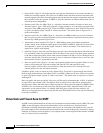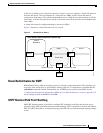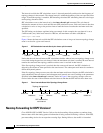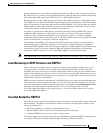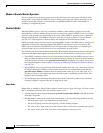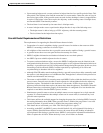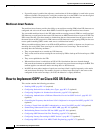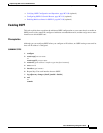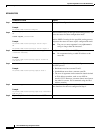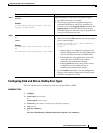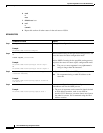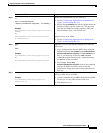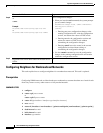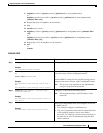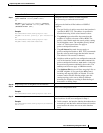
Implementing OSPF on Cisco IOS XR Software
How to Implement OSPF on Cisco IOS XR Software
RC-146
Cisco IOS XR Routing Configuration Guide
DETAILED STEPS
Command or Action Purpose
Step 1
configure
Example:
RP/0/RP0/CPU0:router# configure
Enters global configuration mode.
Step 2
router ospf
process-name
or
router ospfv3
process-name
Example:
RP/0/RP0/CPU0:router(config)# router ospf 1
or
RP/0/RP0/CPU0:router(config)# router ospfv3 1
Enables OSPF routing for the specified routing process, and
places the router in router configuration mode.
or
Enables OSPFv3 routing for the specified routing process,
and places the router in router ospfv3 configuration mode.
Note The process-name argument is any alphanumeric
string no longer than 40 characters.
Step 3
router-id {
ipv4-address
|
interface-type
interface-instance
}
Example:
RP/0/RP0/CPU0:router(config-ospf)# router-id
192.168.4.3
Configures a router ID for the OSPF process.
Note We recommend using a stable IP address as the
router ID.
Step 4
area
area-id
Example:
RP/0/RP0/CPU0:router(config-ospf)# area 0
Enters area configuration mode and configures an area for
the OSPF process.
• Backbone areas have an area ID of 0.
• Nonbackbone areas have a nonzero area ID.
• The area-id argument can be entered in dotted-decimal
or IPv4 address notation, such as area 1000 or
area 0.0.3.232. However, you must choose one form or
the other for an area. We recommend using the IPv4
address notation.
Step 5
interface
type instance
Example:
RP/0/RP0/CPU0:router(config-ospf-ar)# interface
POS 0/1/0/3
Enters interface configuration mode and associates one or
more interfaces for the area configured in Step 4.
Step 6
Repeat Step 5 for each interface that uses OSPF. —



